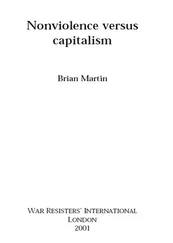Big radio — large, powerful stations with many listeners — is only one sort of radio. There are also a number of other possibilities. Community radio, in which a station is run with a great deal of participation from local people, and in which the power and range of the broadcast is limited, is much more suited to a resistance. [8] . Bruce Girard (ed.), A Passion for Radio: Radio Waves and Community (Montreal: Black Rose Books, 1992); Ron Sakolsky and Stephen Dunifer (eds.), Seizing the Airwaves: A Free Radio Handbook (Edinburgh: AK Press, 1998); Lawrence Soley, Free Radio: Electronic Civil Disobedience (Boulder, CO: Westview, 1999).
If a city has thousands of community radio stations rather than a dozen dominant stations, it is much better situated to resist a takeover. The greater the diversity of stations, the more likelihood that some of them will be willing to take a stand.
Even more valuable for nonviolent struggle are radio systems that are cheaper and that transmit to only a few people. Citizens band or CB radio is mainly used for person-to-person communication, and is ideal. Even more valuable is short-wave radio, since it can be received thousands of kilometres away. It would be impossible to shut down communication out of a country if every household had a short-wave radio, supplemented by many “public short-waves,” namely short-wave radios available for anyone to use, like public telephones.
Short-wave radio was important in the resistance to the Fiji coups in 1987. Fiji became independent of Britain in 1970. The Alliance Party, led by Ratu Kamisese Mara, controlled parliament until 1987. In that year, a coalition of the National Federation Party and the newly formed Labour Party won the election. Six weeks later, there was a military coup led by Lieutenant Colonel Sitiveni Rabuka. The coup was justified by the false claim that the rights of the majority Melanesian Fijians were under threat; the real effect of the coup was to check the challenge to the chiefs of Eastern Fiji who had exercised power via the Alliance Party. But by using the rhetoric of ethnic problems, Rabuka was able to justify the coup in the eyes of many Fijians and outsiders.
Censorship of the media within Fiji was imposed. However, since Fiji is composed of many islands, short-wave radio is widely used and, after the coup, provided direct access to foreign news. In the complicated political situation after the coup, the loyalties of the Fijian people, and also of governments and people overseas, were wooed. For example, Australian trade unions banned the loading or unloading of ships going to or from Fiji. The Rabuka regime applied pressure on the Fiji trade union leaders to say that their rights were protected; after a few assurances were provided, the Australian bans were suspended. Meanwhile, Fiji Labour Party leaders tried to mobilise support from other governments, to little avail. [9] . Brian Martin, “Lessons in nonviolence from the Fiji coups,” Gandhi Marg , Vol. 10, No. 6, September 1988, pp. 326-339.
One potential limitation of radio is that it is possible for anyone to listen in. Therefore, using short-wave radio to send a message could lead to the sender being tracked down and arrested. But this is more likely if only a few people have access to short-wave transmitters. The more people who have access and skills to use the technology, the less likely anyone is to be targeted. The introduction of public short-waves would reduce the risk still further.
Even better protection is possible using packet radio. A computer is attached to a radio transmitter. A message is typed into the computer, which is then transmitted in digital form to a receiver. No one can simply “listen in.” To decipher the message, a suitable computer programme would be required. Even greater security would be provided by putting the message into code. The packet radio transmission can be sent up to a ham radio satellite, which saves the message and transmits it later, perhaps halfway around the world. Packet radio has enormous potential value to a nonviolent struggle.
One other vulnerability of radio is electricity. All large transmitters and most small transmitters and receivers depend on electricity, usually delivered through the grid. For the smaller systems, this vulnerability can be easily reduced. Electricity can be provided by generators — such as an automobile engine — or batteries. For example, a laptop computer and transmitter for packet radio can easily run on batteries. There is also the possibility of radios running on very tiny amounts of power, that can be supplied by batteries, solar energy, or just a wind-up spring such as for a manual alarm clock. [10] . On micropower radio, see Ron Sakolsky and Stephen Dunifer (eds.), Seizing the Airwaves: A Free Radio Handbook (Edinburgh: AK Press, 1998); Lawrence Soley, Free Radio: Electronic Civil Disobedience (Boulder, CO: Westview, 1999).
In the 1960s, Victor Papanek and Richard Seeger designed a cheap (9 cent) radio receiver for the Third World, based on a used juice can and parafin wax. [11] . Victor Papanek, Design for the Real World: Human Ecology and Social Change (London: Thames and Hudson, 1985, second edition), pp. 224-227.
In summary, there are a number of ways to make radio facilities more useful to nonviolent struggle. As with television, radio broadcast facilities could be designed so that technicians, staff or even viewers could interrupt transmission in case of a hostile takeover. Broadcast facilities could be designed so that, in case of emergency, a special signal was transmitted along with the normal signal indicating a hostile takeover. Special tapes could be produced — dealing with methods of nonviolence, ways to undermine control of television by aggressors, etc. — and stored safely for transmission in case of emergency. Information and kits for building small radio transmitters and amplifiers can be disseminated. Cheap, simple-to-use, durable and reliable CB and short-wave radios could be designed and mass produced. The short-wave radios in particular could be designed for smuggling into countries with repressive governments. Encryption for person-to-person radio transmissions can be developed.
Use of audio and video cassettes creates less of a vulnerability than broadcast radio and television, since people use different cassettes. Cassettes are similar to books, in that a relatively few people produce them, but there is a considerable diversity and lack of central control over producing them. With inexpensive video cameras, it is now possible for many more people to produce video cassettes.
Audio cassettes played a role in the Iranian revolution of 1978-79. The Shah of Iran began his rule in 1953. His regime seemed invincible. With enormous oil revenues, he created a massive military machine. Secret police terrorized the population through torture and killings. The regime was actively supported by the United States government and was not opposed by the governments of Israel, the Soviet Union or most Arab countries. This apparently overwhelmingly powerful government was brought down by mass nonviolent action, triggered by religious opponents. The speeches of Ayatollah Khomeini, in exile, were circulated on cassette tapes. Funerals, held forty days after deaths, became protests. When police opened fire and killed mourners, further funerals were held. Opponents burned pictures of the Shah in front of spy cameras of the secret police. Tens of thousands of nonviolent demonstrators were shot dead by troops. Eventually sections of the military defected, and the regime quickly collapsed. [12] . David H. Albert (ed.), Tell the American People: Perspectives on the Iranian Revolution (Philadelphia: Movement for a New Society, 1980); F. Hoveyda, The Fall of the Shah (London: Weidenfeld and Nicolson, 1980).
(It should be said that although the Shah’s regime was toppled largely by nonviolent methods, the successor theocratic regime led by Khomeini was also highly repressive.)
Читать дальше












